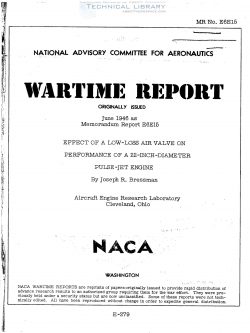naca-wr-e-279
- Version
- 69 Downloads
- 799.70 KB File Size
- 1 File Count
- April 15, 2017 Create Date
- April 15, 2017 Last Updated
Effect of a Low Loss Air Valve on Performance of a 22'' Diameter Pulse Jet Engine

The performance of a 22--inch-diameter pulse-Jet engine using
a set of lawless modified air valves was determined in thrust-
stand tests at rem pressures equivalent to simulated flight speeds
of O to 350 miles per hour and for a range of fuel-air ratios at
each simulated flight speed. The results of these tests are com-
pared with tests of the standard pulse-Jet engine .
In general, the modified engine showed an improvement in per-
formance only at low simulated flight speeds. The predicted flight
thrust at high simulated flight speeds was slightly lower than that
for the standard engine, and the specific fuel consumption was
higher. From the results of these tests, it appears that only a
negligible change in-the over-all performance of the engine can be
expected from low-loss valves. '
At the request of the Bureau of Aeronautics, Navy Department,
and the Air Materiel Conimend, Army Air Forces, the NACA has under-
taken a study of methods of increasing the power and the efficiency
of the pulse-Jet engine. The nonreturn air valves in the engine
have been found to have relatively high losses and it was therefore
decided to investigate the possibilities of a low-loss valve to
improve the performance of this engine. Valves with reduced losses
as compared with the standard valves should permit the flow of larger
masses of charge air, which would result in higher combustion-chamber
densities at the start of combustion and higher peak combustion pres-
sures. The higher peak pressures should result in an increase in
both the power and the efficiency of the engine. (See reference 1.)
An investigation of various types of air valve was conducted in
an apparatus that tested a small section of a pulse- or intermittent-
Jet engine valve grid (reference 2) and a low-loss valve was developed
that could be substituted for the standard valve without further altar-
ation to the engine.
| File | Action |
|---|---|
| naca-wr-e-279 Effect of a Low Loss Air Valve on Performance of a 22'' Diameter Pulse Jet Engine.pdf | Download |

Comment On This Post